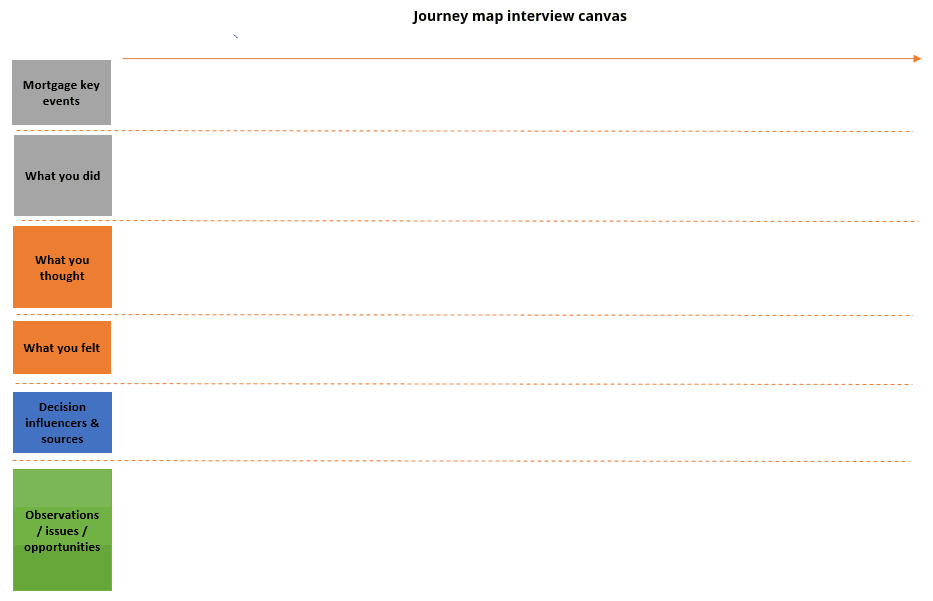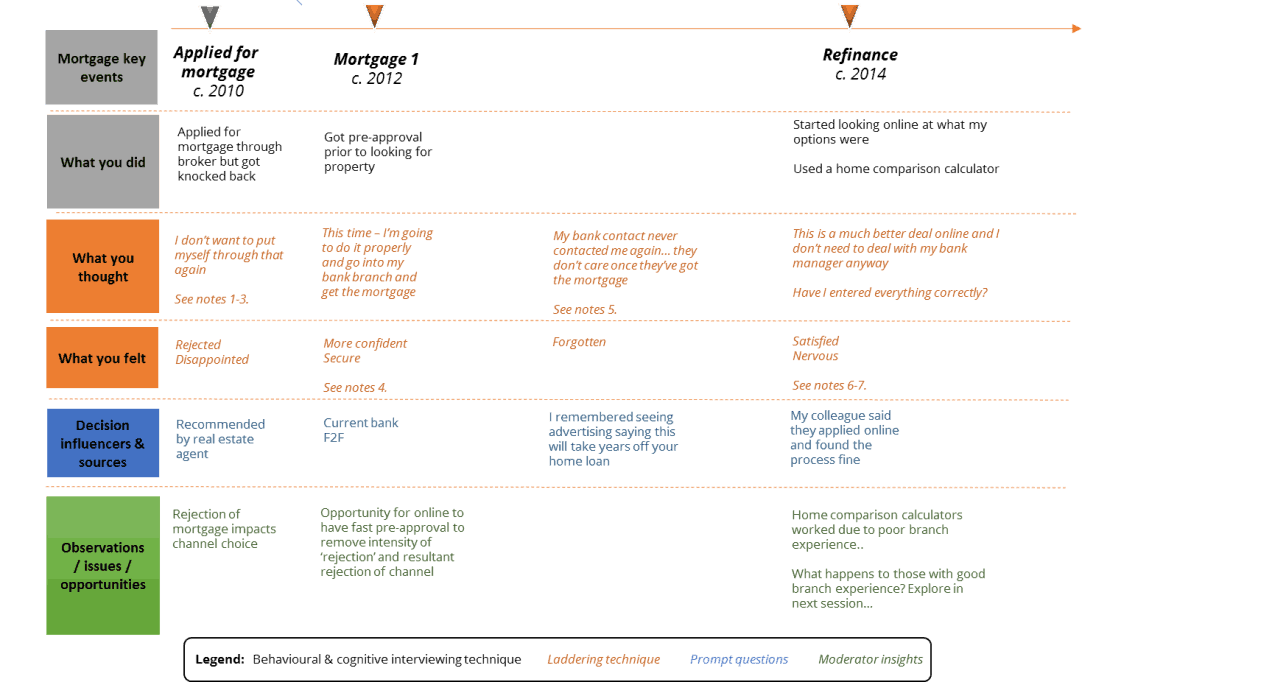You’re probably all familiar with customer journey maps as a user research output and/or design tool. But their usefulness can also extend to the research process, especially when you are trying to understand user decision-making. That is, the journey map can be a useful visual tool for both participant and moderator in a one-on-one interview.
Journey maps can be used to map out users’ behaviour and delve into the beliefs, attitudes and emotions that underpin this behaviour. When coupled with some research techniques grounded in cognitive psychology, you have a very sound and rigorous approach to understanding your user’s decision-making.
Cognitive psychology 101
Let’s start with some fairly well-established ‘truths’ in cognitive psychology. When you are trying to understand user decision-making, a good place to start is past behaviour. There are a few reasons for this:
- Past behaviour can’t be falsified – it happened. You are not asking users general questions like ‘What do you think you would do in this situation?’. You are asking them ‘What did you actually do in this situation?’. This behavioural interviewing approach is quite established in social science research and widely applied across varied industries such as market research, human resources (remember the interview question – ‘give me an example of how you did this in the past?’), and even criminal investigations.
- Past behaviour is also a useful marker for future behaviour. This is a well-accepted trend among psychological scientists, albeit with caveats.
So, if past behaviour is a good place to start, how do we best capture an accurate picture of what happened in the past? And how do we help participants remember what actually happened?
Here we need to understand how memories are constructed and retrieved. Cognitive psychology scientists have found that memories comprise of a network of associations, and are best retrieved when the context surrounding the event is re-instated. Remember the last time you lost your glasses or mobile? You will often ask yourself a series of questions to ‘reconstruct’ what happened. For example: what were you last doing with them? what did you do next? what were you wearing at the time? did you put it in your pocket or handbag?
A technique called cognitive interviewing (CI) can assist users in memory recall of their past behaviour. This is a well-established technique in criminal investigations to help witnesses and/or victims remember actual events, but can be equally applied to other fields. It focuses on ‘context reinstatement’ to facilitate best possible reconstruction of a memory that may not be top-of-mind. Asking a series of questions to reinstate context, such as ‘what else was happening at the time?’ or ‘do you remember who you were with?’, ensures the memory has sufficient attention to surface during the interview.
Have you noticed that memory recall is not linear? If we go back to the lost glasses example, you’ll notice there will be a lot of jumping around in your responses.
“I had the glasses on when reading, then I put them on the table before I went to answer the phone. Oh no, hang on, that’s right, I still had them on when answered the phone. And then when I was talking I took them off… they might be next to the phone….” and on the quest goes.
This ‘jumping around’ effect happens because memory recall is associative, not linear. To get a linear sequence of events from users, a visual tool to help focus their attention is useful.
Journey maps as a research tool
This is where the use of a journey map comes in. The moderator can use this simple visual cue to remind and refocus the participant that together they are aiming to understand the full sequence of events. Mapping out some key swim lanes on the journey map (printed on A3, example below) also serves the dual purpose of acting as the interview guide for the moderator and allows them to easily see the gaps in questioning.

Once you’ve established the actual decision-making behaviour that has occurred, you then may want to dig deeper and understand the beliefs, needs, emotions underpinning this behaviour. Again, social scientists tell us that behaviour is usually underpinned by an affective (what I feel) and cognitive (what I think) component (borrowing from the ABC model of attitudes). Here an interviewing technique called laddering can apply which assists to drill down to core beliefs, attitudes and emotions associated with past decision-making behaviour. In summary, this technique uses a series of progressive ‘Why?’ or ‘How come?’ or ‘how did that make you feel?’ questions to get to the underlying attitudes and thoughts related to a behaviour.
How this might work in practice
Here is an example of this approach applied to the home loan journey. Let’s say a large financial institution wants to understand how users make decisions around home loans, triggers for switching and the role of their website in this. You will be talking to a range of users and want to understand for each user, their home loan journey.
- Firstly, introduce the goal of the session. State that together you are going to reconstruct the home loan journey they have had and that you will be filling out a ‘timeline’ together.
- Focus first on filling out the key events and behaviours – the top horizontal rows of your journey – with behavioural questions such as ‘what did you do?’ followed up with cognitive interviewing techniques to help reconstruct memory where they are struggling to remember. You find their memory jumps around a lot, so you use the journey map as a guide to bring their attention back to a linear story i.e. ‘what happened next?’.

- Then focus on the vertical swim lanes of thoughts and feelings using your laddering technique. You may find that behaviours, thoughts and feelings all tumble out together as the user’s narrative unfolds. This is the process working as memories are reconstructed, just allow the journey map canvas to give direction to the interviewing process. Tip: Have a notepad handy once you start delving into the vertical swim lanes as there will be more ‘narrative’ you want to capture than you can fit on your A3 canvas; use a numbering system to tie notes back to the ‘canvas’.
- We recommend to leave a section at the end which is designated for specific prompt questions you might have (such as decision influencers and information sources), and for moderator insights, observations and identified opportunities. The latter is interpretative and can be completed by the moderator during or after the session, and allows key emerging themes, hypotheses and insights to be captured while the research is in progress.

At the conclusion of your research, you will have a set of individual participant journeys from which you have a robust and rigorous basis to build customer journeys, personas, identify issues, general insights and opportunities.
In summary
- The field of cognitive psychology helps us to understand how memories are constructed and provides useful techniques for optimal memory retrieval, and ultimately more valid research insights.
- The use of journey maps serve the dual purpose of a participant focal point to arrive at a linear user narrative as well as moderator interview guide.
- The end research and associated outputs are rigorous, robust and defensible utilising this approach ensuring future designs and associated decisions are informed and evidence-based.
Tip
Microsoft PowerPoint is a useful tool when designing wireframes, especially when you need to design them collaboratively. Due to their wide use and familiarity, engaging stakeholders to give their inputs on wireframes would be easier than using a complex wireframing software that they are not familiar with.